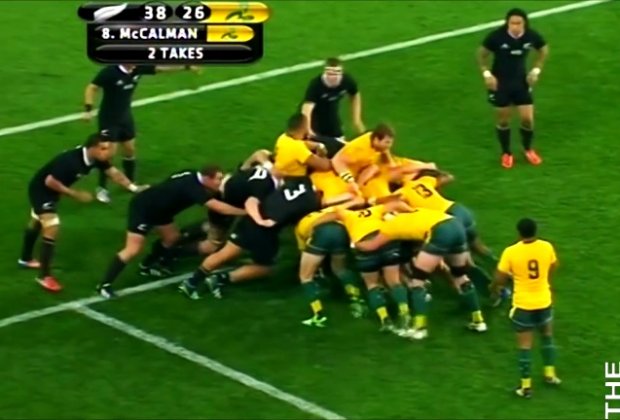At 62 minutes into Bledisloe III, and the Wallabies down by 38-26, they gambled.
Receiving a penalty deep in All Blacks’ territory, captain James Horwill opted to go for the corner. It was a great call. Astute Super Rugby fans have been waiting all year for the extended rolling maul, which the Reds used to such great effect earlier in the season, to make its appearance on the international stage.
Yet somehow it all went awry. Here we’ll explore what the Wallabies were trying to do, what happened, and identify how the Wallabies can ensure a better yield next time.
The extended maul
The idea of the extended maul is a simple one: with (at least) two backs joining the maul process, you add more legs to the drive while – crucially – keeping the ball further away from the opponent. The Wallabies execute the set-up quite well here. The ball goes to Simmons at three, and is ripped by Mowen at five. Mowen then filters to the back of the maul while the other pushers pass over him – and continuing to keep in contact with the maul to prevent a ‘truck and trailer’ call.
What goes wrong
Very little goes wrong here. The maul is perhaps too broad at the front. The key to an extended maul is keeping it narrow, to accentuate any efforts by the opponent coming around the side. But this is a minor quibble. The other problem is that at the right corner of the maul, James Horwill (somehow) gets ‘popped’, so he stands up and is more of a hindrance than a help. The maul then stops and referee Craig Joubert calls ‘use it once’.
But Horwill manages to right the situation, get his head back on the inside, and recover his body position. The maul splinters, with one unfortunate All Black, Kieran Read, continuing to be bound to Horwill, meaning that the peel off is still the same maul.
Joubert whistles that the Wallabies have not ‘used it’ and rules a turnover.
What are the ‘take-homes’?
The worst thing for the Wallabies to do here would be to get gun shy. With the score as it was, at this point in the match, this was absolutely the right call. A try would have put them within a score of the All Blacks with 15 to go. The extended maul, when set up well, is very, very hard to stop.
The Wallabies should instead feel hardly done by. The relevant law here is 17.6 (e):
“When a maul has stopped moving forward it may start moving forward again providing it does so within 5 seconds. If the maul stops moving forward a second time and if the ball is being moved and the referee can see it, a reasonable time is allowed for the ball to emerge. If it does not emerge within a reasonable time, a scrum is ordered.”
The maul is stationary, Joubert calls it as such, but it promptly restarts moving forwards and continues to do so. It’s very unclear to me, if Joubert doesn’t blow his whistle and an All Black doesn’t illegally prevent it, how there isn’t a try scored within the next three seconds. It’s also unclear to me how Brodie Retallick (No.19) doesn’t get pulled up for coming in the side; by the time the main maul splinters (of which he is a key cause) his body is parallel to the goal line.
But whinging at the ref gets the team nowhere, looking forward. (There were other bad calls – like the one at 53:06, just before the decisive Kieran Read try, where Joubert fails to call ‘no clear release’ on a strip off James Slipper that looks straight out of the IRB manual. That hurt the Wallabies.)
But what the Wallabies did really well after the maul call was stick to the game plan. They were genuinely varied in their approach and they never died wondering. The resilience shown could hardly have been more different from what happened in Sydney and Wellington and it bodes very, very well moving forward.

